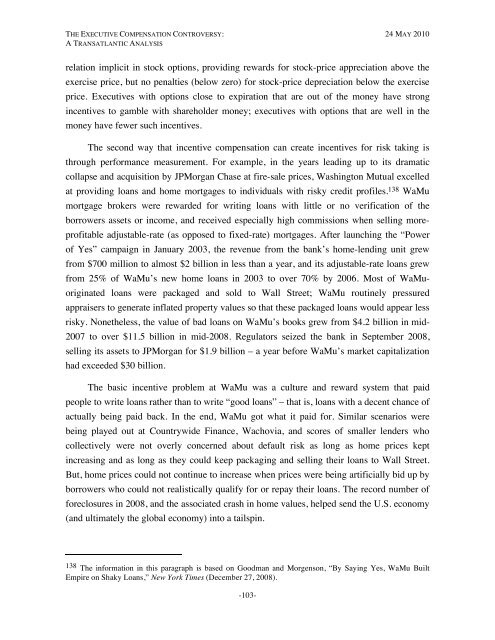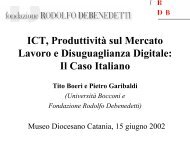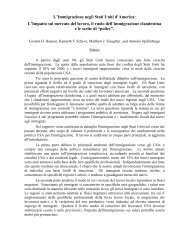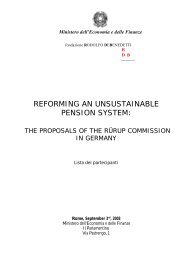The Executive Compensation Controversy - Fondazione Rodolfo ...
The Executive Compensation Controversy - Fondazione Rodolfo ...
The Executive Compensation Controversy - Fondazione Rodolfo ...
Create successful ePaper yourself
Turn your PDF publications into a flip-book with our unique Google optimized e-Paper software.
THE EXECUTIVE COMPENSATION CONTROVERSY: 24 MAY 2010A TRANSATLANTIC ANALYSISrelation implicit in stock options, providing rewards for stock-price appreciation above theexercise price, but no penalties (below zero) for stock-price depreciation below the exerciseprice. <strong>Executive</strong>s with options close to expiration that are out of the money have strongincentives to gamble with shareholder money; executives with options that are well in themoney have fewer such incentives.<strong>The</strong> second way that incentive compensation can create incentives for risk taking isthrough performance measurement. For example, in the years leading up to its dramaticcollapse and acquisition by JPMorgan Chase at fire-sale prices, Washington Mutual excelledat providing loans and home mortgages to individuals with risky credit profiles. 138 WaMumortgage brokers were rewarded for writing loans with little or no verification of theborrowers assets or income, and received especially high commissions when selling moreprofitableadjustable-rate (as opposed to fixed-rate) mortgages. After launching the “Powerof Yes” campaign in January 2003, the revenue from the bank’s home-lending unit grewfrom $700 million to almost $2 billion in less than a year, and its adjustable-rate loans grewfrom 25% of WaMu’s new home loans in 2003 to over 70% by 2006. Most of WaMuoriginatedloans were packaged and sold to Wall Street; WaMu routinely pressuredappraisers to generate inflated property values so that these packaged loans would appear lessrisky. Nonetheless, the value of bad loans on WaMu’s books grew from $4.2 billion in mid-2007 to over $11.5 billion in mid-2008. Regulators seized the bank in September 2008,selling its assets to JPMorgan for $1.9 billion – a year before WaMu’s market capitalizationhad exceeded $30 billion.<strong>The</strong> basic incentive problem at WaMu was a culture and reward system that paidpeople to write loans rather than to write “good loans” – that is, loans with a decent chance ofactually being paid back. In the end, WaMu got what it paid for. Similar scenarios werebeing played out at Countrywide Finance, Wachovia, and scores of smaller lenders whocollectively were not overly concerned about default risk as long as home prices keptincreasing and as long as they could keep packaging and selling their loans to Wall Street.But, home prices could not continue to increase when prices were being artificially bid up byborrowers who could not realistically qualify for or repay their loans. <strong>The</strong> record number offoreclosures in 2008, and the associated crash in home values, helped send the U.S. economy(and ultimately the global economy) into a tailspin.138 <strong>The</strong> information in this paragraph is based on Goodman and Morgenson, “By Saying Yes, WaMu BuiltEmpire on Shaky Loans,” New York Times (December 27, 2008).-103-









